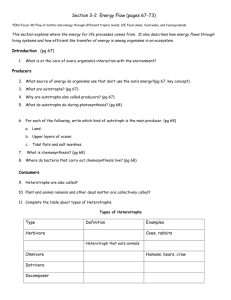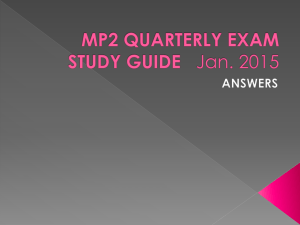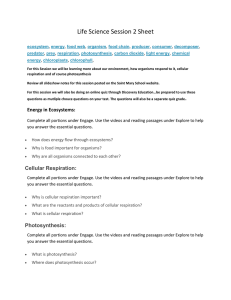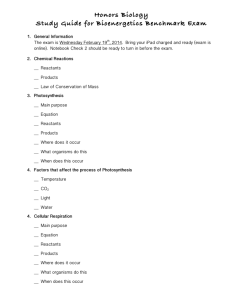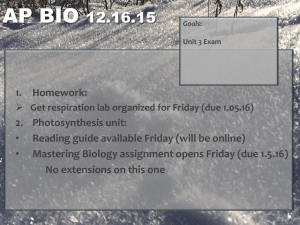Unit 2 Chapter 5.1
advertisement
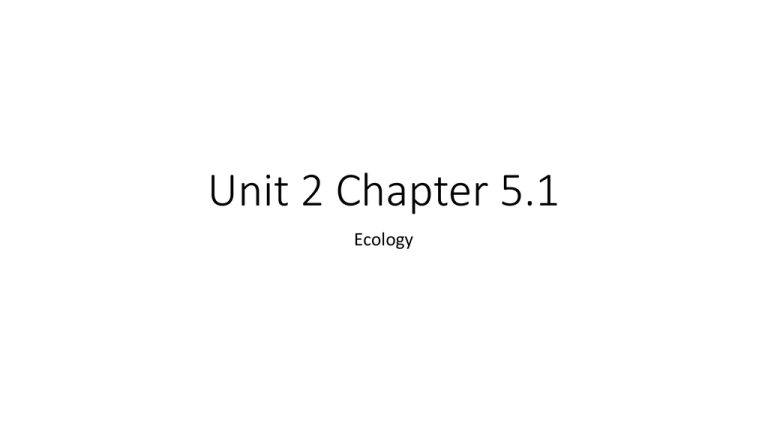
Unit 2 Chapter 5.1 Ecology Biosphere • All life on Earth and all parts of the Earth where life exists • Includes land, water and atmosphere Ecology • Ecology – the scientific study of the interactions between organisms and their physical environment. • Environment – all conditions or factors surrounding an organism. • Environment includes two main types of factors: • Biotic factors – living factors in the environment • Example: fish, snails, algae and plants • Abiotic factors – non-living factors in the environment • Example: water, gravel, temperature, light Energy, Producers and consumers • Energy is needed for growth, reproduction and all processes in the body • Without energy we cannot live!!! • Where does all energy on Earth come from? • The sun!!! • Only certain organisms can capture energy from the sun and convert it into a form they can use • These include algae, certain bacteria and plants • Energy is converted into a form living cells can use Primary Producers • These organisms are called autotrophs or primary producers because they can make their own food using light energy from the sun and are the first producers of energy rich compounds other organisms need to survive • • • Use energy from sun to convert inorganic compounds into organic molecules (sugar) Organisms that eat autotrophs then use energy stored in the bonds of these organic molecules Without autotrophs there would be no energy or food for organisms on the planet!!!!! Remember Photosynthesis?? Can there be life without light? • Yes! • About 30 years ago scientists found ecosystems around deep ocean vents where it is very dark. • These organisms use a process called chemosynthesis to harness energy from inorganic molecules instead of photosynthesis since there is no light Consumers • Heterotrophs – cannot capture light energy from the sun • Must get energy from other organisms by consuming them • That is why they are also called consumers! • There are several different types of consumers depending on what they eat! Types of Consumers • Herbivore – eat plant leaves, roots, seeds, fruits • Examples: cow, caterpillars, deer • Carnivore – kill and eat other animals • Examples: snakes, dogs, cats, river otter • Omnivores – eat both plants and animals • Examples: humans, bears, pigs • Scavengers – eat carcasses of other animals that have been killed by predators or have died of natural causes • Example: vultures Types of Consumers • Decomposers – feed by chemically breaking down organic matter (dead plants and animals) • Produces detritus: small pieces of decaying plants and animals • Example: Bacteria and fungus • Detritivores – chew or grind up detritus particles into smaller pieces • Examples: mites, shrimp, snails and crabs Cellular Respiration: Burning the Fuel • An organism obtains energy from the food it eats. • This food must be broken down within its body. • The process of breaking down carbohydrates to yield energy is called cellular respiration. • Cellular respiration occurs inside the cells of most organisms. Cellular Respiration: Burning the Fuel • During cellular respiration, cells absorb oxygen and use it to release energy from food. • Through cellular respiration, cells use glucose (sugar) and oxygen to produce carbon dioxide, water, and energy. Cellular Respiration: Burning the Fuel • Part of the energy obtained through cellular respiration is used to carry out daily activities. • Excess energy is stored as fat or sugar. Energy Transfer • Each time an organism eats another organism, an energy transfer occurs. • This transfer of energy can be traced by studying food chains, food webs, and trophic levels. Food Chains • Primary produces and consumers are linked through feeding relationships • Energy is passed from producers to various consumers • Food chain – organisms transfer energy by eating and being eaten • Can vary in size from big to small Food Webs • Many animals eat more than one kind of food • So feeding relationships in an ecosystem are usually much more complicated than a chain • Food web – shows the network of feeding interactions • Food web links together all the food chains in an ecosystem Disturbance in food webs • A change in a population of just one of the species in the food web can affect all the other species! What would happen if a toxin killed all the spiders? Ecological Pyramids • Each step in a food chain or food web is called a trophic level • Primary producers always make up the first level • Consumers make up the other levels • Ecological pyramids show the trophic levels in an ecosystem and the relative amount of energy and matter at each level • Three types: pyramids of energy, pyramids of biomass and pyramids of numbers Pyramids of Energy • Each level stores a small portion of energy from the previous level • Energy is stored in the tissues • Organism spend a lot of the energy they get on life processes like respiration and growth • Most of the remaining energy is lost to the environment as heat • Show the relative amount of energy available at each trophic level of a food chain or web Energy Transfer • The efficiency of energy transfer from one trophic level to another varies • Typically 10% of the energy available at one level transfers to the next • The lower the consumer is on the pyramid the less energy it receives • The amount of original energy from the producer is very small once it reaches this consumer


